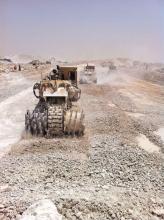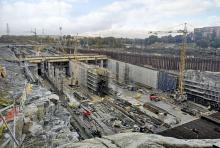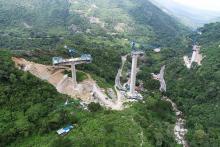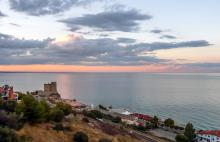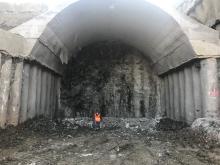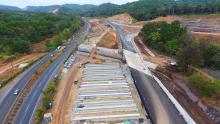
Qatar’s fast-growing capital Doha is benefiting from a massive ring road project that will help decongest the centre of the city. The new highway will also provide extra capacity able to cope with anticipated traffic growth as Doha, a financial centre for the Middle East, continues to expand. Building Qatar’s 195km Orbital Highway and Truck Route (NOH) has proven a major challenge, with the sheer scale of the work involved and the logistics required being major factors. Looping around Doha, the NOH is designed to improve transport connections for Qatar’s eastern coast. The route provides a link between the industrial city Mesaieed, located to the south of Doha, and the city of Al Khor, lying to the north of Doha.
Construction of the highway will help to reduce the heavy congestion that Doha has suffered from during peak periods in its downtown area. Light vehicles, and more importantly heavy trucks, will be able to travel around the city and this will cut journey times by as much as 50% while allowing for the future traffic growth.
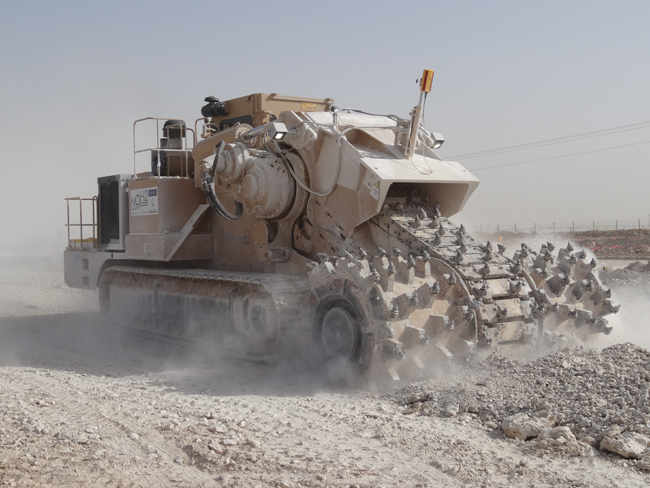
The new NOH is linked at its main interchanges with a number of key roads in Doha, including the Dukhan Highway, Salwa Road, the G Ring Road and Al Wakair Street. These routes run from Doha’s coastal area, with the Dukhan Highway and Salwa Road in particular resembling spokes on a wheel and connecting to the traditional city centre. As the city continues to expand in the future, the areas outside of the bypass will be ripe for development for both industrial and residential purposes.
Qatar’s massive economic strength is fuelling its overall growth, with development focussed on the capital, Doha. Improved infrastructure has been set as a priority by the authorities and the NOH project itself forms part of Qatar’s overall Expressway Programme. In all, major highway projects with a total value of US$8.1 billion have been initiated by Qatar’s Public Works Authority (
The Expressway Programme is itself part of a plan called Vision 2030. In addition to the new road system, this includes the project to build the new Hamad Port (new Doha Port), to the south of Doha, which is costing an estimated US$7.4 billion and covers an area of 26.5km2.
The development includes a new port, a new base for the Qatar Emiri Naval Forces and the Qatar Economic Zone 3. The warehousing, storage buildings and security facilities cover an area of 53ha.
The first vessels began using the facility in 2015, with commercial shipping switching from the old Doha Port in December 2016. The only large vessels now using the old port are cruise ships.
Qatar’s pressing need for better transport infrastructure has been further boosted by the 2022 Fifa World Cup being held in the country. The NOH has been designed to link with the key stadia being used for the World Cup, including the Al Rayyan, Al Khor and Lusail sites. It also connects with a number of other new sporting facilities erected around Doha. However, the need to have the bypass ready in time for the 2022 event required the work to be carried out within a tight schedule.
But of the highways being built in the country, the new NOH is the biggest and has been designed to provide enormous capacity. Its length, the numerous interchanges and the additional structures required mean that multiple civil structures and utilities are necessary.
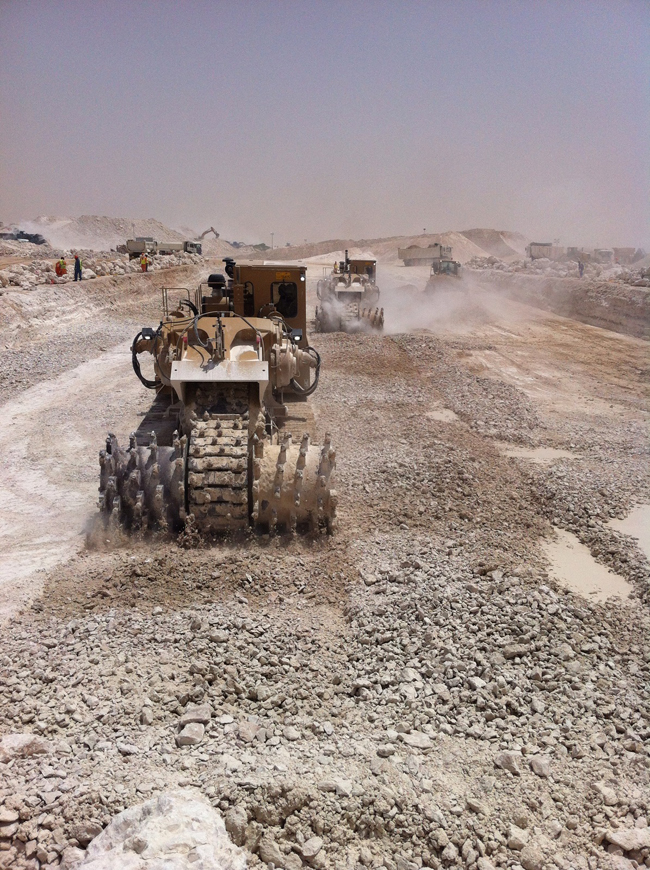
The central section of the route is designed for passenger cars and other light vehicles only, featuring five lanes running in either direction. Running parallel on either side of this main highway are twin lanes, which are dedicated for carrying heavy truck traffic. Keeping the light vehicles and heavy vehicles apart serves two main purposes. Firstly, it allows for better traffic flow as the trucks are slower-moving and less manoeuvrable than the lighter vehicles. Secondly, this improves safety for all road users by ensuring the trucks are away from the more vulnerable lighter vehicles. To further optimise safety for users, the lanes for cars and light vehicles are separated from those carrying heavy trucks by concrete barriers running along the sides. However this configuration, with five lanes in either direction for light vehicles as well as two lanes in either direction for heavy vehicles, has added to the complexity of the various interchanges considerably.
Because of its sheer scale, Qatar’s public works authority Ashghal has planned the NOH project in four separate phases, with these including the building of 21 interchanges, as well as tunnels and flyovers.
Construction work for the project commenced in 2014 and building the first contract for the NOH itself has required the construction of a 45km stretch of road lying to the south and west of Doha. The US$896 million contract for the design and construction of this first phase of the highway was handled by J&P. The firm engaged WSP to design this stretch of the route, with this task including the design of the four grade-separated interchanges.
Work started for the various stages of the project at different times due to its scale and the first new link road to the NOH was opened slightly earlier in March 2017. This 5km stretch of connector road runs between the new Hamad Port, which lies to the south of Doha, and joins with the Truck Route.
The section includes a multilevel interchange with Mesaieed Road and features four lanes in either direction. The link to the port was prioritised, due to its importance for Qatar’s international trade.
The second stretch of the route, Contract 2, lies to the west and north of downtown Doha. This runs between the interchange with Salwa Road and the interchange with the North Relief Road. The work to build NOH contract 2 consisted of the design and construction of 47km of highway with a five-lane highway for light vehicles in either direction. It also included two parallel lanes in either direction for truck traffic. The length of this stretch means that numerous civil structures have had to be built, including six viaducts, 17 bridges and underpasses and a 320m cut-and-cover tunnel.
This section includes eight grade-separate interchanges featuring cross roads, collectors-distributors and overpass and underpass structures. It also has pedestrian and bicycle facilities, while the work includes landscaping around the various structures. In addition to the road building itself, there are numerous ancillary works such as a new and more efficient storm water drainage system, treated sewage effluent networks, electrical and telecommunications systems, street lighting and substations.
Tendering for the second section of the project was carried out in 2014 and the $1.6 billion contract was subsequently awarded to a joint venture team comprising QDVC and Bin Omran Trading & Contracting Company. QDVC is a Qatari company comprising local firm
One novel feature of Contract 2 is the way much of the route has been excavated. QDVC opted to use mechanised cutting, utilising a fleet of eight
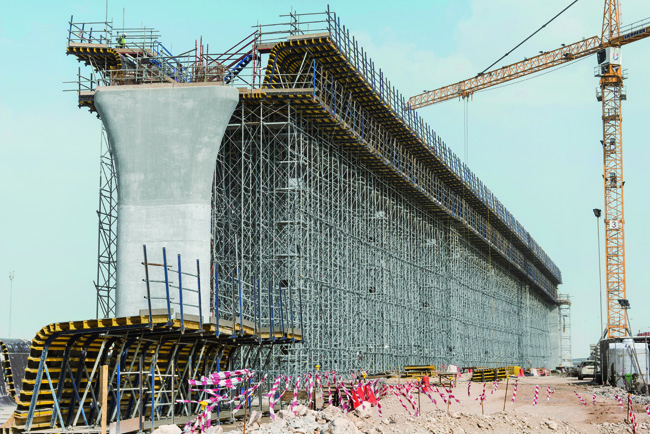
Each of the 110tonne 1475 RH machines is powered by a 470kW
In addition to avoiding the potentially unpredictable nature of explosives, the mechanical method almost eliminated the problem of flyrock. Dust production from the cutting process can be localised and can be controlled when required using water spraying, while ensuring site personnel stay in their climate-controlled machine cabs so as minimise exposure.
The noise levels of the mechanised cutting system were far lower and generated no shock waves from blasting, an important factor when operating close to any inhabited areas. Meanwhile, the excavated floor was also much more even than would have been the case using blasting, providing a better base to build the road upon. In addition, the cuttings from the excavation process were more uniform in size and easier and less costly to handle. There were no oversized materials so there was no requirement for secondary breaking. The rock produced could even be processed using screening equipment and subsequently used in backfilling or for road base applications, reducing costs with regard to buying or transporting materials to site.
Compared with other more conventional methods of mechanical excavation, such as using hydraulic excavators fitted with breakers, the use of the Tesmec 1475 RH machines was more productive, and again delivered a more uniform size of broken materials.
A further benefit of using the Tesmec 1475 RH for excavation was that this type of machine could also be used for driving cuttings with vertical sidewalls, because the drum is wider than the machine’s own tracks. And as the drum is centrally supported, the cuttings made by the machine required minimal finishing. By comparison, using blasting to excavate a cutting would result in cracking in the rock and more uneven surfaces, requiring considerably more support.
Another another important stage in Package 2 of the project has been the construction of the civil structure for Junction 3. This measures 18m high and has two bridge sections measuring 383m and 390m in length. The longest span between supports measures 13.7m. Special methods employed in the construction include the use of formwork systems from
Doka’s team used a series of combinations such as Staxo 100 eco with steel profiles, Top 50, D3 and SL-1 HD shoring. The firm used the components to produce novel shoring configurations and panels. This was a factor in the engineering hours on the project exceeding 20,000 hours, which included supervision on site.
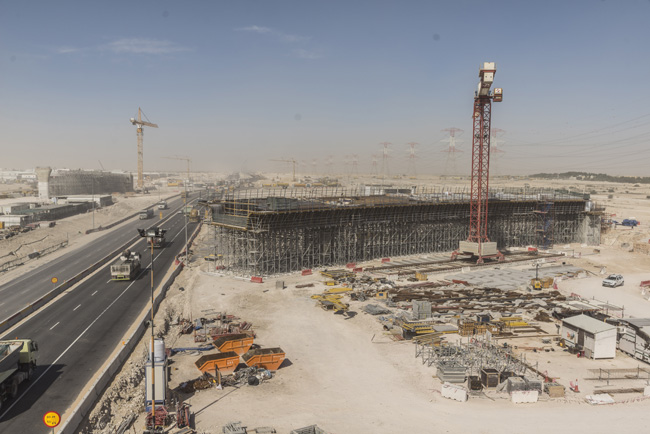
Doka had to prepare its operations beforehand so features such as the shoring erection sequence, weight to be carried, integrated safety equipment on the material, access to the work area, and dismantling sequences were all carefully calibrated by the firm’s engineers. This helped to ensure a safe, productive, and cost-efficient solution for completing the project. Some of the value-added elements used by the Doka team included 3D modelling, screw jack extensions for each shoring tower made with AutoLISP, and wood boxes cut by
The third phase of the project required the construction of a 55km stretch of highway that links Mesaieed with Salwa Road. A joint venture comprising Leighton Contracting Qatar and
The fourth phase of the NOH project lies to the north of Doha, connecting the Dukhan Highway with the Al Khor Link Road. This stretch is for 42km of highway, and incorporates five grade-separated interchanges. As with the other sections of the route, the number of lanes has added to the complexity of the structures required.
Firms that have handled the temporary and permanent traffic control systems for the NOH project have included Arcadis and SALFO & Associates.
Qatar transport overview
Qatar’s Expressway Programme involves building an integrated infrastructure network. This is being equipped with sophisticated technology for traffic control and includes the latest intelligent transport systems. It also includes storm water networks to prevent flash flooding as well as electrical services for the lighting and traffic control systems and general utilities.


